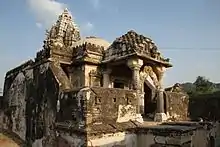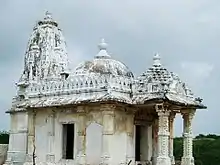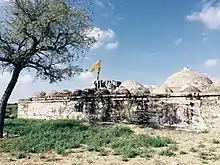Nagarparkar
Nagarparkar (Urdu: نگرپاركر, Sindhi: ننگرپارڪر), is a taluka in at the base of the Karoonjhar Mountains in Tharparkar District in Sindh province of Pakistan. The historic Churrio Jabal Durga Mata Temple is situated here. The taluka is located at a distance of 129 km from Mithi, in Sindh, Pakistan.
Nagarparkar
نگرپاركر | |
|---|---|
Taluka | |
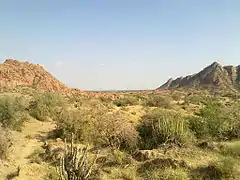 Nagarparkar view from the Karoonjhar Mountains | |
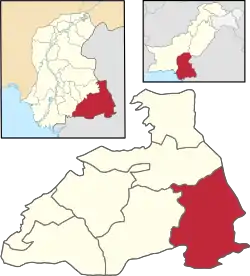 | |
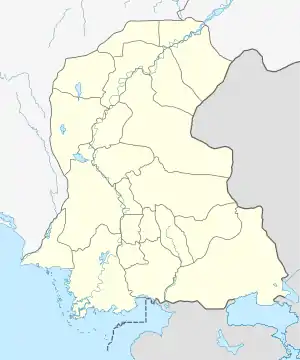 Nagarparkar  Nagarparkar | |
| Coordinates: 24°21′21″N 70°45′16″E | |
| Country | |
| Province | Sindh |
| District | Tharparkar |
| Time zone | UTC+5 (PST) |
Description
The name comes from the original word Nangar Parkar. It is at the foot of the Karoonjhar Hills. It is situated at a distance of about 16 km from south and about 23 from east from the Indian border. At one time the area was under the sea, which had to be crossed; the name "Parkar" means "to cross over". Nagarparkar has Taluka Chachro on its north, and on its west is Taluka Mithi of Tharparkar District, while on east of it lies Barmer (Rajasthan) and on its south is Rann Kachchh. The surrounding area is a rocky belt called Parkar, and the remaining part is a sandy area.
The Karoonjhar hills surround Nagarparkar for 16 miles. The granite stone of this mountain is used for making tiles. There is a saying that the Karoonjhar hills provide 1-1/4 kilos of gold every day in the form of red granite stone, china clay, and honey. In summer, different sounds are audible from the rock due to sulfur deposits.
Nagarparkar Jain temples
The region once had a significant Jain population. Shri Gaudi Parshvanth Stavan in 1650 described the Parkar as the most glorious of all regions of India.[1]
The remains of a number of Jain temples are popular tourist attractions and heritage sites in the region.[2]
Churrio Jabal Durga Mata Temple
Churrio Jabal Durga Mata Temple, on Churrio Jabal hill in Choryo village, is one of the two Hindu temples in this place. On Shivratri 200,000 pilgrims visit the temples. Hindus cremate the dead and ashes are preserved till Shivratri for immersion in the into holy water. Richer Pakistani Hindus go to India to immerse the ashes in Ganges and the rest visit Nagarparkar to immerse the ashes. This area has been leased by the government for the mining by dynamite blasting of the hills on which the temples are located. This is posing a threat to the temples. Angry pilgrims held a protest against mining.[3]
Demographics
The population of the taluka is 153,106, out of which 90,893 are Hindus and 62,213 are Muslims. There is one rest house beneath the Karoonjhar Mountain, but it partially collapsed during the 2001 Gujarat earthquake. This region is an ancient place of Hindu worship. Sardharo, Anchlesar, and Jain temples are situated there.
Gallery
See also
References
- Shri Gaudi Parshvanth Stavan, Bhanvarlal Nahta, Shri Gaudi Parchvanath Tirth, Muni Jinavijaya Abhinandan Granth, Ed. Dalsukh Malvania, Jinavijayaji Samman Samiti, Jaipur, 1971, p. 263-275
- "Vanishing temples of Thar and Nagar Parkar, Ameer Hamza, Dawn, October 21, 2006".
- Contractor blasting through Tharparkar temple in search of granite , The Express Tribune, 10 Mar 2011.
External links
 Media related to Nagarparkar at Wikimedia Commons
Media related to Nagarparkar at Wikimedia Commons Nagarparkar travel guide from Wikivoyage
Nagarparkar travel guide from Wikivoyage

